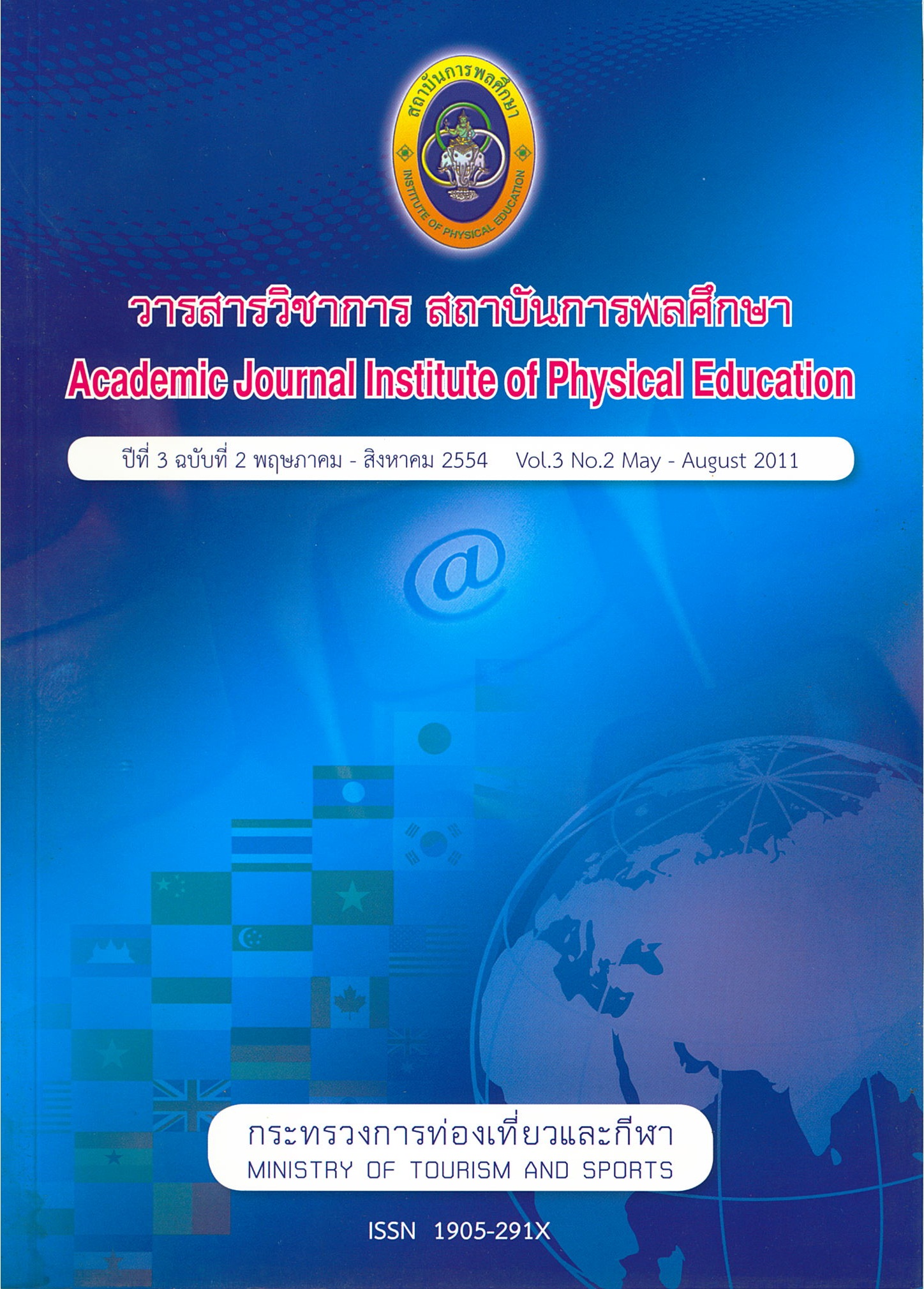Physical Exercise Behaviors Through Playing and Sport Watching of the People in Five - Provincial Responsible Areas of Institute of Physical Education Srisaket Campus
Main Article Content
Abstract
The purpose of this research was to bring the results of this investigation to be used as the way of instruction development of Institute of Physical Education Srisaket Campus in 2005 in order to develop the learners' characteristics of being the physical exercise leaders in accordance with the community and social needs. The samples consisted of 2,000 people and were drawn by random sampling from 5 provinces, namely; Srisaket, Ubonratchathani, Surin, Yasothorn, and Amnatcharoen. Each province comprised 400 people. Data were analyzed by using SPSS for Windows. Findings were as follows:
- The people exercised and played sports 87.35 %. People in municipality zone were 87.87 % and out of municipality zone were 87.31 %.
- The people who exercised and played sports indicated the main reasons as follows:
2.1 for their health (76.78 %)
2.2 for their joy (51.25 %)
2.3 for enhancing their physical fitness (37.61 %)
2.4 for the competition (23.52 %)
2.5 for socializing with new colleagues (19.21 %)
3. The usual places for exercise and sport playing, namely;
3.1 around in their home / neighborhood (59.31 %)
3.2 at their school playground (48.45 %)
3.3 at the Sub - District Administrative Organization playground (21.95 %)
3.4 at a multipurpose playground (16.25 %)
3.5 at a temple playground (14.50 %)
3.6 the exercise time sessions were 5.00 P.M. - 7.00 P.M. (51.42 %) and 3.00 P.M. - 5.00 P.M. (25.22 %).
4. The people who got the most benefit of exercise and sport playing got strong muscles (65.65 %), enjoyable and relaxed (55.80 %), a better physical fitness (39.10 %), a better sleep (35.40 %), a better body shape (33.32 %), and better heart, lung, blood vessel systems respectively (27.35 %).
5. The people who exercised and played sports prepared themselves for exercise and sport playing the most were taking a warm-up activity (52.45 %), spending at least 30 minutes for exercise (49.25 %), playing until they got tired (40.90 %), proper dressing sportswear (33.95 %), and spending at least 2 hours for playing after the meal respectively (9.65 %).
6. The top five of sports that people watched and played were Soccer (59.01 %). Volleyball (48.00 %), Sepak - Takraw (27.70 %), Muay - Thai (19.40 %), and Basketball respectively (19.20 %).
7. 37.25 % of the people periodically watched the sports the most. They watched occasionally (27.75 %), watched everyday (17.12 %), and watched only the important match respectively (15.90 %).
8. The people who knew how to watch the sports watched from TV. the most (78.94 %), in the sport stadium (56.70 %), from sports news (49.32 %), from newspaper (25.45 %), from sports magazines (13.55 %), and from Video / VCD respectively (7.85 %).
9. The people who didn't exercise and play sports reasoned that
9.1 there were no time (43.09 %) 9.2 they were not interested in any sport (21.54 %) 9.3 they lacked of sport equipment (6.75 %) 9.4 they lost time in working (5.47 %).
Article Details
The published article is a copyright of the Academic Journal of Thailand National Sports University. The passage appeared in each article in this academic journal is a perspective of each author which is not related to the journal. Each author is required to be responsible for all components of his/her own article. If there are any mistakes, each author must be responsible for those mistakes on his/her own.
References
กรมการพัฒนาชุมชน. (2548). หมู่บ้านชนบทไทย จากข้อมูลพื้นฐานระดับ หมู่บ้าน (กชช.2ค) ปี 2548. กรุงเทพฯ : แอล ที เพรส.
การท่องเที่ยวและกีฬา. (2548). มติ ครม. เรื่องยุทธศาสตร์ 4 ปี สร้างกีฬาชาติ, http://www.mots.go.th
กระทรวงสาธารณสุข. (2544). การสํารวจภาวะอนามัยสุขภาพประชาชน ระดับจังหวัด ครั้งที่ 3 พ.ศ. 2544. กรุงเทพฯ: ม.ป.ท.,
การกีฬาแห่งประเทศไทย. (2546). การสํารวจการออกกําลังกาย เล่นกีฬา และดูกีฬาของประชาชน พ.ศ. 2544. สํานักวิชาวิทยาศาสตร์การกีฬา จุฬาลงกรณ์มหาวิทยาลัย.
จรวยพร ธรณินทร์. (2525). กายวิภาคและสรีรวิทยาของการออกกําลังกาย, พิมพ์ครั้งที่ 2. กรุงเทพฯ : ไทยวัฒนาพาณิช.
ชูศักดิ์ เวชแพศย์ และกันยา ปาละวิวัธน์. (2536). สรีรวิทยาของการออกกําลังกาย, พิมพ์ครั้งที่ 4. กรุงเทพฯ: ธรรกมลการพิมพ์.
ถนอมวงศ์ กฤษณ์เพ็ชร์. (2544). พฤติกรรมการออกกําลังกาย เล่นกีฬา และกีฬาของประชาชนในกรุงเทพมหานคร. วารสารสุขศึกษา พลศึกษา และสันทนาการ.
นัยนา เที่ยงภักดี. (2542). ความสัมพันธ์ระหว่างทัศนคติต่อวิชาพลศึกษากับพฤติกรรมการออกกําลังกายของนักเรียนระดับมัธยมศึกษาตอนปลาย สังกัดกรมสามัญศึกษา จังหวัดขอนแก่น, วิทยานิพนธ์ ปริญญาศึกษาศาสตรมหาบัณฑิต สาขาวิชาพลศึกษาบัณฑิตวิทยาลัย มหาวิทยาลัยขอนแก่น.
บุญชม ศรีสะอาด. (2545). การวิจัยเบื้องต้น, พิมพ์ครั้งที่ 7. กรุงเทพฯ : สุวีริยาสาส์น.
ประยงค์ นะเขิน และ พัชรินทร์ คณานับ. (2543). พฤติกรรมการออกกําลังกายของข้าราชการสังกัด กระทรวงสาธารณสุขในจังหวัดนครปฐม รายงานการเฝ้าระวังโรคประจําเดือน.
ปรีชา กลิ่นรัตน์. (2536). สู่วิชาชีพพลศึกษาและธุรกิจกีฬา, ขอนแก่น: ขอนแก่นการพิมพ์.
พิชิต ภูมิจันทร์ และคนอื่น ๆ. (2530). วิทยาศาสตร์การกีฬา, กรุงเทพฯ : บริษัทต้นอ้อ จํากัด.
วรศักดิ์ เพียรชอบ. (2531). ประโยชน์ของการออกกําลังกาย, กรุงเทพฯ : นิตยสารการท่าเรือ,
วาสนา คุณาอภิสิทธิ์. (2545). “หลักสูตรการศึกษาขั้นพื้นฐาน พุทธศักราช 2544” วารสารสุขศึกษา พลศึกษาและสันทนาการ. ปีที่ 28 เล่ม 1 (มกราคม-เมษายน).
วิศาล คันธารัตนกุล. (2546). การออกกําลังกายในวัยทํางาน การออกกําลังกายเพื่อสุขภาพ. กรมอนามัยกระทรวงสาธารณสุข.
วุฒิพงษ์ ปรมัตถากร. (2537). ประโยชน์ของการออกกําลังกาย, กรุงเทพฯ : โอเดียนสโตร์.
สมบัติ กาญจนเจริญ. (2541). พฤติกรรมการออกกําลังกาย. คณะวิทยาศาสตร์ จุฬาลงกรณ์มหาวิทยาลัย.
สุชาดา ภัยหลีกลี้ และ สมไฉน นาถภากุล. (2543). พฤติกรรมการออกกําลังกายเพื่อสุขภาพของประชากรวัยแรงงานในเขตเทศบาลนครขอนแก่น, โครงการวิจัยรับทุนจากสถาบันวิจัยและพัฒนา มหาวิทยาลัยขอนแก่น.
สํานักงานคณะกรรมการพัฒนาเศรษฐกิจและสังคมแห่งชาติ. (2544). แผนพัฒนาเศรษฐกิจและสังคมแห่งชาติฉบับที่ 9 พ.ศ. 2545-2549. กรุงเทพฯ: ศึกษาภัณฑ์พาณิชย์.
สํานักงานพัฒนาการกีฬาและนันทนาการ. มปป. การออกกําลังกาย, สํานักวิทยาศาสตร์การกีฬา, มปป.
Cronbach, Lee J. (1970). Essential of Psychological Testing. 3rd ed. New York: Harper and Row.
Sasakawa Sport Foundation. (2000). The National Sport-Life Survey. (Abstract) 2000. U.S. Department of Public Health Service. Healthy People 2000: Risk Reduction Objective. http://www.crisny.org.2542

